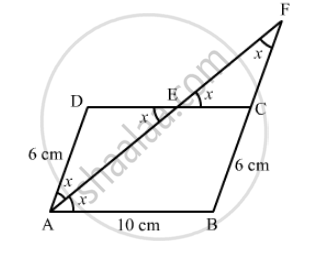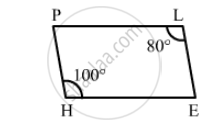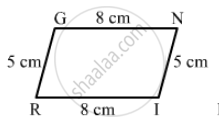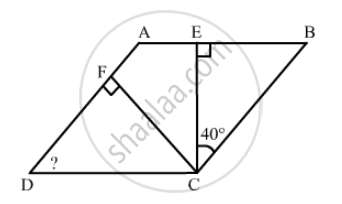Advertisements
Advertisements
प्रश्न
In a parallelogram ABCD, AB = 10 cm, AD = 6 cm. The bisector of ∠A meets DC in E, AEand BC produced meet at F. Find te length CF.
उत्तर

\[\text{ AE is the bisector of } \angle A . \]
\[ \therefore \angle DAE = \angle BAE = x\]
\[ \angle BAE = \angle AED = x (\text{ alternate angles })\]
\[\text{ Since opposite angles in ∆ ADE are equal, ∆ ADE is an isosceles triangle } . \]
\[ \therefore AD = DE = 6 cm (\text{ sides opposite to equal angles })\]
\[AB = CD = 10 cm \]
\[CD = DE + EC\]
\[ \Rightarrow EC = CD - DE\]
\[ \Rightarrow EC = 10 - 6 = 4 cm\]
\[\angle DEA = \angle CEF = x (\text{ vertically opposite angle })\]
\[\angle EAD = \angle EFC = x (\text{ alternate angles })\]
\[\text{ Since opposite angles in } ∆ EFC \text{ are equal, ∆ EFC is an isosceles triangle } . \]
\[ \therefore CF = CE = 4 \text{ cm (sides opposite to equal angles })\]
\[ \therefore CF = 4\text{ cm }\]
APPEARS IN
संबंधित प्रश्न
All rhombuses are parallelograms.
Can the following figure be parallelogram. Justify your answer.

Can the following figure be parallelogram. Justify your answer.

Two adjacent angles of a parallelogram are as 1 : 2. Find the measures of all the angles of the parallelogram.
Find the angles marked with a question mark shown in Fig. 17.27

Which of the following statement is true for a rhombus?
It has all its sides of equal lengths.
Draw a rhombus, having each side of length 3.5 cm and one of the angles as 40°.
Diagonals PR and QS of a rhombus PQRS are 20 cm and 48 cm respectively. Find the length of side PQ.
If the adjacent sides of a parallelogram are equal then parallelogram is a ______.
In a rhombus diagonals intersect at ______ angles.
